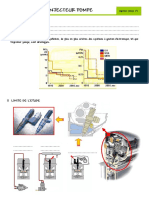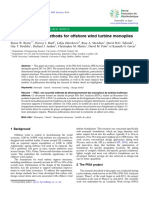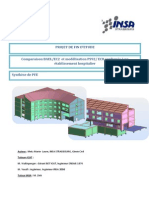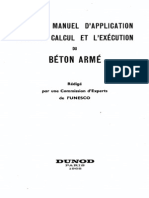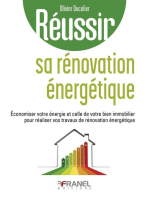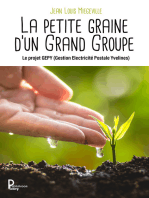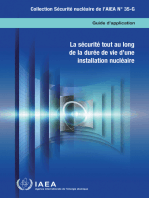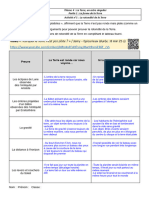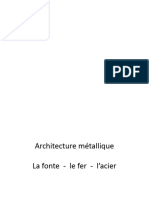G04 Experiences With The Application of Eurocode 7
G04 Experiences With The Application of Eurocode 7
Transféré par
Huy Nguyen VanDroits d'auteur :
Formats disponibles
G04 Experiences With The Application of Eurocode 7
G04 Experiences With The Application of Eurocode 7
Transféré par
Huy Nguyen VanTitre original
Copyright
Formats disponibles
Partager ce document
Partager ou intégrer le document
Avez-vous trouvé ce document utile ?
Ce contenu est-il inapproprié ?
Droits d'auteur :
Formats disponibles
G04 Experiences With The Application of Eurocode 7
G04 Experiences With The Application of Eurocode 7
Transféré par
Huy Nguyen VanDroits d'auteur :
Formats disponibles
Experiences with the application of Eurocode 7
Formations sur l’application de l’Eurocode 7
T.L.L. Orr
Associate Professor, Trinity College Dublin, Ireland
ABSTRACT
Following the implementation in 2010 of Eurocodes 7 and 8 for geotechnical and seismic design in many European countries, a
series of Workshops was held as part of the XV ECSMGE in Athens to share experiences with the application of these Euro-
codes. The Workshop presentations that focused on Eurocode 7 are summarized in this report. These presentations showed the
different ways in which Eurocode 7 is being implemented in ten countries, not only with different Design Approaches but also
with other differences, such as the introduction of safety classes, and with many countries producing additional rules in the form
of non-conflicting complement information. The presentations on pile design to Eurocode 7 revealed that, in addition to different
Design Approaches, many differences still remain in the way pile resistances are determined and many countries have introdu-
ced model factors for pile design. The challenges in using numerical methods for Eurocode 7 designs were examined and future
developments of Eurocode 7 were discussed.
RÉSUMÉ
Après la mise en oeuvre en 2010 des Eurocodes 7 et 8 pour les calculs géotechniques et sismiques dans de nombreux pays Euro-
péens, une série de séminaires a eu lieu pendant le XV CEMSG à Athènes pour partager les expériences d’application de ces Eu-
rocodes. Les présentations faites lors des séminaires sur l’Eurocode 7 sont résumées dans ce rapport. Ces présentations montrent
les différentes mises en oeuvre de l’Eurocode 7 dans dix pays, non seulement du point de vue des différentes approches de calcul
mais également du point de vue d’autres différences comme l’introduction de classes de sécurité, et avec plusieurs pays produi-
sant des règles complémentaires qui ne contredisent pas celles existantes. Les présentations sur le dimensionnement des pieux
selon l’Eurocode 7 ont montré que, en plus des différentes approches de calcul, beaucoup de différences résident encore dans la
façon dont est déterminée la résistance des pieux et beaucoup de pays ont introduit des facteurs de modèle pour le dimensionne-
ment des pieux. L’utilisation de méthodes numériques pour les calculs avec l’Eurocode 7 a été examinée et les futurs dévelop-
pements et approfondissements des Eurocodes 7 ont été discutés.
Keywords: Eurocode 7, implementation, experiences, pile design, numerical methods
1 INTRODUCTION years later, a day consisting of the following five
Workshops on the use of Eurocodes 7 and 8
Eurocode 7 [1], the new European standard for (EC7 and EC8) was organised as part of the XV
geotechnical design, and the other Eurocodes ECSMGE in Athens by those ISSMGE technical
were implemented for public works in many committees (TCs) involved in activities related to
CEN (European Committee for Standardization) the development of geotechnical design codes:
member countries on 31 March 2010. Hence, 1½ 1. Application of Eurocode 8 ETC12
2. Experiences with the ETC10
application of Eurocode 7 is DA2*, in which partial factors are applied to
3. Different national design method- ETC3 the effects of actions, rather than to the actions
ologies for piles according to EC7 themselves, while DA3 is allowed for designs
4. Limit State Design, EC7 ETC7&TC205 involving overall stability and slopes. DA3 may
and Numerical Methods also be used in numerical analyses of retaining
5. Future development and discussion structures. Adopting the option in EN 1990 [2],
All above committees the magnitude of the partial factors in the Aus-
This report summarises the presentations and trian NA have been related to the design situation
issues regarding the use of EC7 identified in the (i.e. persistent, transient and accidental) and the
EC7 Workshops 2 to 5. A report on Workshop 1, Consequences Class (CC) for each type of geo-
Application of EC8, has been prepared by M. technical design. For the design of compression
Maugeri and is also included in this volume. and tension bored piles, the EC7 recommended
partial resistance factor values have been adopted
and model factors introduced so that the overall
2 APPLICATION OF EUROCODE 7 safety factors (OSF) are similar to those used
previously. To avoid confusion between the
Prior to the XV ECSMGE, T. Orr as chair of many partial resistance factors, the symbol η ra-
ETC10, circulated the following questionnaire to ther than γR;d has been adopted for the resistance
geotechnical engineers in some countries to learn factors, with ηR;c = 1.3 for bored piles in com-
about the experiences of applying EC7 in their pression and ηR;t = 2.5 for bored piles in tension.
countries:
1. Do you find EC7 easy to use? Finland
2. Do you use it for all geotechnical design sit- T. Länsivaara reported on the situation in Finland
uations? where the Eurocodes are applied under two dif-
3. Does it provide enough detail? If not, what ferent ministries: the Ministry of the Environ-
more detail would you like? ment (house construction) and the Ministry of
4. Do you as the geotechnical designer choose Transport and Communications (infrastructure),
the characteristic value or does the ground each with a different NA produced to a different
investigation report provide you with a cha- deadline and providing different partial factor
racteristic value? values and implementation rules. These occur
5. Are you confident choosing characteristic because of different safety requirements and load
soil strengths? combinations adopted in Finland for structures
6. Are you happy with the partial factor values and infrastructure projects. Furthermore, the pa-
in your National Annex (NA) and confident of rallel use of existing standards has been extended
the safety of the resulting designs? to an unspecified date by the Ministry of the En-
Experiences with the application of EC7 in vironment. The consequence of this situation is
Austria, Finland, France, Germany, Greece, It- the possibility of confusion regarding the status
aly, Ireland, Sweden, Switzerland and the UK are of the NAs and the implementation of EC7.
presented below. The replies received to the In Finland most piles are end bearing driven
above questionnaire are presented in the cases of into dense moraine or rock. Ground investigation
Germany, Ireland and Sweden using the number- data is not considered very reliable in such con-
ing system above for the questions. ditions and therefore the correlation factors for
resistances based on ground investigation data
Austria have been increased by approximately 30%.
T Orr reported on experiences with applying However, since there has been long and good
EC7 in Austria, based on information provided experience with using dynamic pile testing
by M. Fross. The Design Approach (DA) al- (PDA), a model factor of 0.9 for signal matching
lowed in Austria for spread foundations, pile may be applied for pile design in rock if PDA is
foundations retaining structures and anchorages used. The partial factors on soil strength parame-
ters have been increased for designs close to sen- 1. Since German designers are familiar with
sitive structures to limit deformations and to DIN 1054:2005 but now have to use EC7 to-
avoid the need for serviceability calculations. gether with the German NA, its application is
Also the Consequences Classes have been intro- more complicated, because the number of
duced with three sets of partial factors for design code pages has increased, although some
situations with different risks. parts of the EC7 are not relevant for the Ger-
A further problem, related to EC7, that has man user, e.g. DA1. However, the provision
occurred in Finland is that the new soil classifi- of an EC7 Handbook, containing the EC7
cation in EN ISO 14688-2 [3] classifies the Fin- text, NA and supplementary rules in DIN
nish soil savi as sand whereas, using the previous 1054:2010 in one volume with the rules that
standard, it was classified as clay. The problem is apply in Germany highlighted, facilitates its
how to treat old data relating to this soil. use. Furthermore a Commentary on this
Handbook, with comments on EC7 and DIN
France 1054, has also been published. As part of an
Reporting on the implementation of EC7 in endeavour in Germany to simplify the Euro-
France, J.-P. Magnan said the main activities at codes, a working group consisting of repre-
present are preparing the following design stan- sentatives from consultants, contractors and
dards to complement EC7 and the French NA: manufacturer, has been established for this.
− P 94-261: Shallow foundations 2. EC7 is used for all geotechnical designs in
− P 94-262: Deep foundations Germany. For simple situations, the NA al-
− P 94-270: Reinforced soil lows the use of experience or empirical pa-
− P 94-281: Retaining structures (walls) rameter values, e.g. for the bearing capacity
− P 94-282: Retaining structures (embedded) of piles or shallow foundations. In compli-
− P 94-290: Earth structures. cated cases the observational method is used.
The EC7 recommended partial factor values 3. Regarding the amount of details in EC7, there
have been adopted and DA2 or DA3, depending have always been a lot of additional codes,
on the design. The EC7 Geotechnical Categories recommendations and standardized calcula-
have been adopted and related to the Conse- tion methods for design in Germany. Such
quence Classes. In pile design, either the model detail is not appropriate for EC7 although
pile or the ground model methods may be used. many users would like more detailed descrip-
When using these methods, model factors of 1.1 tions of the calculation methods.
4. The characteristic value is usually selected by
and 1.3 respectively are applied to the ξ values as
it is not considered feasible to achieve the pile the engineer who has investigated the ground
resistance with the 95% confidence level upon and provided the ground investigation report.
5. Designers accept the selection of the charac-
which the EC7 recommended ξ values are based.
teristic value by the ground investigator,
A further factor is applied to obtain an overall re-
mainly for legal reasons.
sistance factor close to 1.4.
6. German designers are generally happy with
Questions that have been raised by the work
the partial factor values adopted in the Ger-
on EC7 have been the compatibility between
man NA because they are calibrated so that
EC7 and EC8 and the equivalence of alternative
the previous safety level is still maintained.
methods such as DA2 and DA3 for overall stabil-
ity analyses and the model pile and ground mod-
Greece
el methods for pile design.
Experiences with the implementation of EC7 in
Greece were reported by M. Kavvadas. The draft
Germany
Greek NA to Part 1 of EC7 was issued in June
M. Ziegler, reporting on the implementation of
2009 and the draft Greek NA to Part 2 was is-
EC7 in Germany, stated that:
sued in February 2010. For persistent and tran-
sient design situations, the EC7 recommended
partial factor values have been adopted. For ac- Ireland
cidental and seismic design situations, all partial T. Orr reported that EC7 became the reference
factors (for actions, resistances and material standard for geotechnical design in Ireland on
properties) are set equal to unity. The Greek NA 31st March 2010. However, due to the economic
states that, for GEO ultimate limit states (ULS), crisis and decrease in construction activity since
DA3 is used for embankments, slopes and deep then, limited experience has been obtained so far
excavations against overall stability failure, in Ireland with the use of EC7. The responses
while DA2 is used for deep foundations, ancho- from Irish geotechnical engineers to the ques-
rages and retaining structures and DA2* is used tionnaire in Section 1 are summarised as:
for shallow foundations. For HYD ULSs, Equa- 1. Irish engineers initially thought EC7 was not
tions 2.9b in terms of seepage forces and sub- easy to use, but once familiar with it, they
merged weights, is chosen. When designing piles find it is easy, although it is more compli-
from ground test results, a model factor γM = 1.3 cated that the traditional method.
is introduced to be compatible with designs 2. EC7 is now used for most geotechnical de-
based on profiles of test results using the correla- sign situations, apart from anchors and some
earthworks, such as rock slopes.
tion factor ξ. All Informative Annexes of EC7 3. It was generally thought that EC7 provided
Part 2 are maintained as informative so that all enough detail, though some thought the
ground testing methods mentioned in this Part, as treatment of the partial factors could be sim-
well as any other internationally accepted testing plified and there could be more information
method, may be used. about the following: a) Pile design using
Prior to the introduction of EC7, the safety ground test result, b) Design of ground an-
factor normally required in Greece for slope sta- chors, and c) Treatment of groundwater.
bility was 1.40 for both effective and total stress 4. Designers choose characteristic values in Ire-
analyses. In an update of the NA, it is planned to land; these are not given in investigation re-
introduce a model factor γR,d = 1.1 in effective ports.
stress analyses for adverse groundwater condi- 5. Irish engineers said their confidence in select-
tions, e.g. for T = 50 years, so that the OSF = ing the characteristic value depended on the
1.10 x 1.25 = 1.38 ≈ 1.40 while for extreme quality of the ground investigation. Imple-
menting EC7 has not increased the quality of
groundwater conditions, e.g. for T = 100 years,
ground investigations - some felt the quality
γR,d = 1.0 and OSF = 1.0 x 1.25 = 1.25. For seis- and scope of investigations had decreased.
mic situations, the same OSF values are ob- 6. Irish engineers are generally happy with the
tained, if partial material factors, γM are un- EC7 recommended partial factors adopted in
changed (as per EC8 – Part 5) the Irish NA. However, some felt the partial
Another change being considered for an up- factors were too high for slope stability ana-
lyses and traditional staged construction on
date of the Greek NA, is the introduction of Re-
soft ground may not be feasible using EC7.
liability Classes (RC) in accordance with EN
Since any one of the three DAs may be used
1990, with different partial factors for materials
in Ireland, the Irish engineers were asked which
and resistances in each RC for the ULS design of DA they used for different designs. The majority
temporary structures and transient situations, e.g. use DA1 for most designs situations and some
temporary slopes and temporary retaining struc- compare the different DAs. Further comments on
tures. Since the EC7 recommended partial factor EC7 and its application in Ireland were that:
values are correlated to Reliability Class 2, with − It was logical and an improvement on previ-
a target probability of failure of 10-4, partial fac- ous standards
tor values for RC1 and RC3 will need to be cor- − The availability of three DAs is causing un-
related with target probabilities of failure of 5 x ease as there is pressure to pick the lightest or
10-4 and 10-5 respectively. safest design, depending on the client. The
time investment to distinguish between the
different DAs is onerous.
Italy public works, where a geotechnical consultant is
Regarding the implementation of EC7 in Italy, typically responsible for the soil geotechnical
G. Scarpelli stated that the Eurocodes are still not model and for the geotechnical design.
directly applicable but their use is substantially With regard to the partial factor values:
possible through the National Code for Construc- − The partial factor values have been selected
tions, the DM ’08 (NTC 08), which is a compul- to obtain equivalent OSF values for ULS that
sory set of prescriptions consistent with all the are greater than or equal to the values in the
Eurocodes and is part of the State Law that go- previous Code (e.g. OSF = 3 for spread foun-
verns the design and execution of all reinforced dations and for DA2 γGx γR = 1.3x2.3 =2.99).
concrete and steel constructions, both public and
− Such a choice obscures the role of servicea-
private, in Italy. The NA for Part 1 of EC7 was
bility limit state (SLS) analyses for geotech-
approved in July 2010. Assuming the use of the
nical design and is strongly criticized by
geotechnical chapter of NTC 08 is equivalent to
some designers as not really being in agree-
using EC7, the typical feedback from practition-
ment with EC7.
ers is that EC7 is not easy and unduly
− The practical use of EC7 should encourage in
complicated. The main change compared to past
the near future a revision of the partial factor
practice has been the introduction of partial fac-
tors in place of global factors In Italy, geotech- values (particularly the values of γR).
nical design always has to consider seismic ac- − A unique set of partial factors on soil proper-
tions and this needs to be done in a consistent ties are used for both static and seismic load
way. Most difficulties in seismic design derive cases.
from the separation of EC7 from EC8, which is
fully reflected in NTC 08. Poland:
Italian engineers feel that new sections of K. Gwizdała, reporting on the implementation of
EC7 are needed to cover the following aspects: EC7 in Poland, stated that the Polish NA to Part
a) Rock mechanics, b) Tunneling, c) Use of EC7 1 of EC7 provides:
with computer design codes, d) Dams and e) Ex- − Detailed scope of the ground investigations
isting structures. for the different Geotechnical Categories.
Some critical issues for Italian engineers re- − DA3 is adopted for the deign of slopes while
garding the implementation of EC7 are: DA2 is adopted for other GEO design
− Being a mandatory code, it must be used for situations, with partial resistance factors
all geotechnical design situations, including according to Eqn 2.7b and with DA2*
minor changes to existing structures (this has adopted for bearing resistance.
a large economic impact on private projects). − The selection of Eqn. 2.9b in terms of
− In Italy, DAs 1 and 2 are the possible choic- seepage force and submerged weight for
es; DA3 is only for slope stability problems; designs against heave failure (HYD).
when left to the designer, the selection of a To demonstrate the reasons for the DAs,
particular DA is a source of confusion. partial factors and heave equation adopted in the
− The use of correlation factors ξ for piles and Polish NA, Gwizdała presented the results of
anchorages to derive characteristic values several design examples. He compared the
from ground test results is strongly criticized; designs of two spread foundations with inclined
this may be appropriate for homogeneous soil and eccentric loads, one on cohesive soil and one
conditions, but these are very rarely found in on non-cohesive soil, according to the Polish NA
the typical Italian geological conditions. using DA2* and also using the other DAs. He
Regarding the selection of characteristic val- then compared the stability of a trench against
ues, very often these are provided by the ground heave failure designed using Eqn. 2.7b in the
investigation report, usually compiled by a geol- Polish NA and Eqn. 2.7a. In his final example,
ogist responsible for the site investigation and Gwizdała showed the importance in pile design
laboratory testing. This is never the case with of taking account of the different amounts of
shaft and base resistance that develop with servational method and produced the basis for
settlement in the case of bored and driven piles. the Swedish NA. IEG finished its activities in
To facilitate implementation of EC7 in spring 2011. One of the benefits of the IEG was
Poland, some universities are offering that leading geotechnical experts in Sweden
postgraduate courses in EC7, some workshops could discuss and come to an agreement how to
on EC7 have taken place recently and there is a use EC7. Its aim was to involve a lot of people
website with information on EC7. who would have to work with EC7 so that its
implementation would be easier and more
Spain prompt. This aim was achieved.
C. Sagaseta stated that the Part 1 of EC7 had In responding to the questionnaire circulated
been translated into Spanish and published by by T. Orr about the implementation of EC7, L.
AENOR (Asociación Española de Normalización Moritz stated that:
y Certificación) in 2011, but the Spanish NA was 1. Swedish engineers thought EC7 was not easy
not yet available and this constituted a serious to use without some additional help, therefore
obstacle to the implementation of EC7. A draft Sweden has provided more detailed national
version of the Spanish NA is being prepared. It rules and associated code requirements.
will be distributed for review and comment be- 2. EC7 is now used for all geotechnical design
fore receiving official approval expected in 2012. situations, but it has only started to be used
Translation of Part 2 is currently taking place and recently.
AENOR will probably publish it in 2012. Saga- 3. EC7 does not provide enough details, hence
seta reported that members of the Spanish sub- the additional rules and requirements men-
tioned in (1) above;
committee on EC7, AENOR SC7-AEN140, have
4. Designers chose the characteristic values in
become integrated into the SC7 Evolution Sweden;
Groups (EGs) and, as much as possible, the work 5. Swedish geotechnical engineers are not con-
undertaken by these groups will be taken into ac- fident choosing characteristic soil strengths
count as the Spanish NA is prepared. but feel that EC7 gives a very good specifica-
tion about the factors that influence them;
Sweden 6. Before EC7 was implemented, Swedish engi-
T. Orr presented a report on the implementation neers were not happy with the new partial
of EC7 in Sweden, based on information pro- factor values, not only because they wanted
vided by L. Moritz. Work on implementing EC7 flexible values, as in the former code, but al-
in Sweden began in 2005 with the establishment so there was the feeling that the safety level
of an association (IEG) consisting of representa- was wrong and mostly too high. However,
tives from ministries, contractors, consultants, since EC7 has been implemented, it appears
universities and manufacturers. This association that Swedish engineers are happy with the
examined projects relating to EC7 and geotech- partial factors as these concerns are no longer
nical standards covering the following aspects: being expressed.
− The differences between EC7 and the old
standards and regulations; Switzerland
− Calculations to calibrate the partial factors H. Schneider reported that EC7 was introduced
and analyze the consequences; to practicing engineers in Switzerland in 2004
through nationwide introductory courses. Uni-
− How to use EC7 in practice, which resulted in
versity courses are now based on the EC7 design
application documents for the design of
philosophy with partial safety factors and young
spread foundations, pile foundations, retain-
engineers use EC7 for all routine problems. Most
ing structures, slopes and embankments, and
senior engineers with more than 6-8 years prac-
structures in rock, and how to treat water in
tice know the EC7 design philosophy and apply
the design, including hydraulic failure.
it but many check their EC7 designs against de-
IEG also studied the application of EC7 in
signs to the old global safety factor system.
field and laboratory investigations and in the ob-
Transferring experience/confidence from the old Table 1: Top 5 topics as voted by UK engineers (based on
global factors to the new partial factors seems to Bond [4])
Rank Topic %*
be much more difficult than mentally changing
1 Add new parts to EC7 covering detailed design 100
the design system. (e.g. footings, walls, pile and slopes)
2 Improve general guidance on selecting charac- 94
UK teristic soil parameter
Regarding the implementation of EC7 in the UK, 3 Improve guidance on selecting water pressures 70
C. Smith, reported that it is being used continu- 4 Add new parts to EC7 covering reinforced soil 59
ously by larger consulting firms, but probably 5 Simplify/reduce number of DAs 43
less so by very small firms. Although there was a * The percentage of votes above the average expected
lot of critical debate during the development of
EC7, the British Standards Institution (BSI) has pile designs in Belgium, and there were 5 other
received very few criticisms of it and most users speakers who reported on pile designs in Estonia,
now comment favourably on it. Training pro- France, Ireland, Poland and Sweden. The final
grammes are offered by several organisations, presentation compared a pile in London Clay de-
such as Geocentrix, universities and the Institu- signed using different codes.
tion of Civil Engineers. He showed two papers
on the design of piles produced with the piling Belgium
industry and now being used fairly readily. M. Bottiau presented a report, prepared with N.
Smith presented examples of two structures Huybrechts and M. De Vos, on pile design in
on different soils with spread foundations de- Belgium. EC7 and the Belgian NA are now
signed to EC7; in the case of one, the Grand compulsory for public works and represented the
Egyptian Museum on Aeolian and alluvial soils, code of good practice for other works. The Bel-
the design was controlled by the SLS while in gian Building Research Institute (BBRI) has pub-
the case of the other, the Coventry University lished Guidelines for the implementation of Eu-
Engineering and Computing Building on sands rocode 7 in Belgium, which are non-conflicting
and clays, the design was controlled by the ULS. complementary information (NCCI) and referred
He also presented the Bahrain-Qatar causeway to in the Belgian NA. The Belgian pile design
bridge, one of the world’s longest bridges, as an method involves the following features:
example of a structure outside Europe being de- − General framework for geotechnical design
signed to EC7 by an international team and the
− Moving from a global to partial safety factors
question arose regarding which NA to use.
− More uniform reliability levels
Smith noted that some consultants had com-
mented that, while EC7 is very specific regarding − Evaluating the soil investigation
the aspects the Ground Investigation and Geo- − Assessing existing pile foundations (quality
technical Design Reports should cover, it is not control, static load tests)
very clear on how feasibility stage studies or ‘de- − A design framework for new types of founda-
sign and build’ contracts should be reported. He tion piles (static load tests).
also presented the results of a survey by Bond [4] The first three features listed above are the main
on what improvements to EC7 the industry new features. To illustrate the design methodolo-
would like, which are shown in Table 1. gy, Bottiau presented the method for designing a
compressive pile from CPT results. The base and
shaft resistances were calculated using the de
3 PILE DESIGN TO EUROCODE 7 Beer method, with reduction factors for pile
shape, an enlarged base, installation effects and
The second Workshop examined the different na- soil type, and values were given for these factors.
tional design methodologies for piles according Except for driven and jacked piles, model fac-
tors, whose values depend on the pile type and
to EC7. The Workshop was introduced by M.
whether or not an instrumented static load test
Bottiau, chairman of ETC3, who also reported on
has been carried out, are applied to the calculated French NA gives ξ values to determine Rk from
resistances. The characteristic resistances are pile load tests and an “alternative method” using
then obtained by applying correlation factors correlations with Ménard Pressuremeter (MPM)
whose values depend on the number of CPT tests test results to determine pile end bearing and
per m2 and the flexibility of the structure. Finally shaft resistances. He also presented a method to
the design resistances are obtained by applying predict the pile settlement based on MPM EM
partial factors, whose values depend on whether values for different soil types and questioned if
or not there is a quality guarantee for the piles settlement calculations were only appropriate for
involving monitoring and certification. When SLS designs. Examining the reliability of pile
there is no quality guarantee, the partial factors designs in France, Frank noted that the maximum
are 0.05 greater than the EC7 recommended target reliability index values in EC7 for building
DA1-C2 values. The Belgian method links the foundations for SLS and ULS are β = 1/500 and
safety level of pile designs to the uncertainties 1/150 and the maximum total and differential
involved since the ξ values are reduced when settlements are 50mm and 20mm, whereas in
there is more ground investigation (more CPT practice in France lower β values for SLS and
tests per m2), the model factors are reduced when ULS of 1/250 and 1/1000 to 1/500 are used.
instrumented static load tests are carried out, and
the partial factors are reduced when there is qual- Ireland
ity control during execution. K. Gavin reported that Ireland permits the use of
any of the three DAs for geotechnical designs,
Estonia including pile design. Depending on the type of
In reporting on pile design in Estonia, M. Metz pile, the EC7 recommended partial factors have
raised the problem of defining the pile resistance been adopted with either increased ξ factors or a
since it is a combination of the base and shaft re- model factor so that the OSF obtained is similar
sistances, which occur at different pile displace- to that pertaining previously. Since SPTs are
ments, are calculated using different equations, commonly used to investigate the ground condi-
and have an influence on each other, depending tions, models which correlate pile capacity and
on the geotechnical conditions. Hence he posed SPT N values are widely used. The shaft adhe-
the question: Is the pile resistance a single value sion factor, α and the cu are commonly used
or does it have many values? EC7 is now used when designing piles from ground test results.
for geotechnical design in Estonia, but for a long Static load tests are often performed to low pile
time previously, the Russian SNiP code was head displacements and extrapolation to deter-
mandatory. In this code, the creep limit load, Ny, mine the pile resistance can be unreliable.
determined from pile load tests and taking into
account time dependence, was used as the work- Poland
ing load. A good correlation has been established K. Gwizdała presented a report on pile design in
between the bearing resistance determined from Poland. Polish versions of EC7 Parts 1 and 2
dynamic load tests and Ny. Metz said higher pile have been published and the NA for Part 1 states
displacements were required to mobilize shaft re- that, except for slopes, DA2* has been adopted
sistance than the minor displacements required for all design situations, with γE = 1.0 and γE >
for creep when load is transferred from the pile 1.0. He showed how much more information can
to the soil. As an example of situations favoring be obtained from a static load test on an instru-
the use of N y for pile design, he gave the beha- mented pile, by measuring the vertical distribu-
vior of piles in varying ground conditions, with tion of axial force along the core of the pile, than
soft ground over hard or hard ground over soft. on a non-instrumented pile. The piles for a
bridge over the Odra River near Wrocław were
France presented as an example of where such loading
R. Frank reported on pile design to EC7 in tests on instrumented piles had successfully been
France where DA2 has been adopted and the used. The Polish standard, PN-83/B-02482 pro-
vides values of the unit base and shaft resistances
of piles that, depending on the soil type, are re- AASHTO
lated either to the Density Index or the Liquidity
Index. Gwizdała concluded by showing the use UK EC7 (DA1-2)
of non-linear transfer functions to predict the
load settlement behavior of piles. Conventional - FOS = 3.0
IRL EC7 (DA2)
Sweden
G. Axelsson reported that, in implementing EC7
in Sweden, the Swedish standard has two NAs, AS2159 2009 NL EC7 (DA3)
VVFS for infrastructure and BFS for buildings,
and these are now used for all designs. An
SNiP
additional document, TD Pile Foundation, has
been published providing guidance on Section 7
of EC7 on pile design. Pile resistance is normally
obtained from dynamic or static pile tests. Pile
Figure 1. Comparison of pile designs to different codes
driving formulae are not allowed. DA2 has been
adopted for the geotechnical design of piles and General
DA3 for the structural design. Three safety P. Vardanega presented the results of the design
classes, with modification factors of 0.83, 0.91 of a 0.9m diameter pile in London Clay carried
and 1.0, have been introduced that reduce the out with E. Kolody, S. Pennington, P. Morrison
EC7 recommended DA2 and DA3 partial action and B. Simpson, all of Ove Arup & Partners. He
factors for two of the safety classes. The adopted showed how different characteristic cu values
resistance factor values are slightly less than the could be selected due to the scatter in the test da-
EC7 recommended values due to the confidence ta and depending on the rational adopted. The
in Sweden in pile design methods based on load pile designs were all based on the α method. The
tests. In certain cases model factors are also ap- calculated pile lengths, obtained using a conven-
plied, for example when using dynamic testing tional factor of safety of 3.0 and using six codes
with a CAPWAP analysis, the calculated resis- of practice, three being EC7 with different NAs
tance is divided by a model factor of 0.85, i.e. it and partial factors, are presented in Figure 1.
is increased, whereas when using wave equation These show that the global factors of safety
analysis the calculated resistance is divided by a (FOS) for the piles ranged from about 1.7 in the
model factor of 1.3. If the pile resistance is cal- case of the Russian SNiP code to about 4.0 for
culated from ground test results, depending on the AASHTO code, with the FOS for the three
the soil type and testing method, model factors EC7 designs close to 2.5. He concluded that:
ranging from 1.1 to 1.6 are applied to reduce the − Most codes do not mandate a settlement
calculated bearing resistance. check
Axelsson listed the following Swedish con- − The Russian approach tolerates more move-
cerns regarding pile design to EC7: ments.
− Buckling is only checked when cu < 10 kPa and he posed the question regarding pile design:
− Pile driving formulae may be used Are we all designing the same thing?
− Failure is defined as s/D = 10% of the pile
base diameter
− Model factors are needed 4 NUMERICAL METHODS
− The high level of safety on actions
− No reduction of correlation factors for stiff C. Sagaseta, chair of ETC7, chaired Workshop 4
structures with dynamic testing on “Limit state design, Eurocode 7 and Numeri-
− Calculation of downdrag. cal methods” with 5 presentations on the use of
numerical analyses for ULS designs to EC7.
H. Schweiger examined the applicability of − Should numerical models be used in this
numerical methods for EC7 designs, without way? Has sufficient experience been accumu-
recommending a particular DA, and noted some lated with numerical models to perform ULS
important issues to be considered. When using design analyses?
DA1-C1 and DA2, it is not feasible to factor the − Due to the significant influence of the consti-
earth pressure. Alternatively, the effects of ac- tutive model and other modelling assump-
tions can be factored and this is referred to as tions, is it reasonable to use numerical meth-
DA2*. Two options are possible with DA3: in ods as the basis to design deep excavations?
Option 1 the analysis is performed using design, − The relative stiffness between the soil and the
i.e. factored, strength values. This option pro- wall influences the design forces, though the
vides no SLS information. In Option 2 the analy- magnitude seems to be relatively small and to
sis is performed using characteristic parameters, depend on the constitutive model used.
but for all construction steps a check is made Hence, should there be partial factors on soil
with reduced parameters. This option provides stiffness?
SLS as well as ULS information. − The fact that soil is both a load and a resis-
Schweiger presented four examples of exca- tance is only covered consistently in DA1 and
vations supported by retaining walls, two DA3;
benchmark examples and two case histories, and − How should water pressures be dealt with in
compared the maximum calculated design bend- DA3 (they are fully factored in DA2)?
ing moments and shear forces in the walls using − Should K0 be based on the characteristic or
two soil models. He concluded that:
design friction angle?
− DA2 and DA3 lead to different retaining wall D. Potts outlined two possible approaches to
designs (as with conventional analyses); account for the FOS in a numerical analysis. Ap-
− The choice of constitutive model and some proach 1 is to start the numerical analysis with
modelling assumptions may have a larger ef- unfactored strength values and gradually increase
fect than the choice of DA; the FOS (i.e. reduce the strength at relevant
− The differences between DA2 and DA3 ap- stages) until failure occurs. The advantages of
pear to be less pronounced for advanced con- this approach are that a single analysis is used to
stitutive models. investigate both SLS and ULS. The disadvan-
The arguments in favor of DA2 and DA2* and tages are inconsistent strength reduction ap-
against DA3 (or DA1.C2) are that: proaches in different software and some software
− “Real" soil is considered; can only perform such reductions if simple con-
− The "Limit state" of working load conditions stitutive models are used.
is obtained; Approach 2 is to start the numerical analysis
− Only one analysis is required (not exactly with factorised strength values and continue until
true if variable loads are present); failure occurs. The advantages of this approach
− Unrealistic system behavior (e.g. struts in are it is the easier alternative, no software modi-
tension) is avoided. fication is needed, and it can be used with most
The arguments against DA2 and DA2* and for constitutive models. The disadvantages are the
DA3 (and DA1.C2) are that: initial stresses may not be consistent with those
− A partial factor is placed on one of the in-situ (Ko could be reduced) and an additional
uncertainties - the soil parameters analysis is needed to investigate serviceability.
− Soil is both a load and a resistance and this is From the results of numerical analyses of
not always clear cut but is automatically three examples, consisting of the bearing capac-
taken into account in DA1 and DA3. ity of a footing on Tresca soil, on Modified Cam
While the application of numerical methods Clay and on soil using Lade’s double hardening
complying with EC7 is possible in general, model, he concluded that:
Schweiger asked the following questions:
− Different approaches in numerical analyses to 5 CONCLUSIONS AND DEVELOPMENT
account for FOS can lead to different results;
− Understanding how the software performs the Workshop 5, the final workshop, was a general
strength reduction and how this interacts with discussion session based on the earlier EC7 and
the constitutive model is important; EC8 Workshops. This final Workshop was chai-
− Guidelines are needed to ensure that this po- red by B. Simpson, convener of TC 250, who in-
tential pitfall is avoided. vited the chairmen of the earlier Workshops to
L. Zdrakovic compared the use of the above summarize their outcomes and present the issues
two approaches for three retaining wall exam- that had arisen for discussion.
ples: a cantilever embedded wall, a single- Summarizing Workshop 2 on the application
propped embedded wall, and a double-propped of EC7, Orr said:
embedded wall. She showed that, when analys- − Most countries have implemented EC7
ing embedded retaining walls, both strength re- − Generally those using EC7 are happy with it
duction approaches lead to the same results when and confident in the safety of the designs ob-
a simple Mohr-Coulomb model is used but can tained
give different results when a non-linear model is − Different DAs are used in different countries;
used. For multi-propped walls, ULSs are likely − Model factors have been introduced so as to
to involve structural failure and consequently a achieve appropriate level of safety, particu-
factor of safety also needs to be applied to the larly for pile design
structural strength. However, both strength re- − Most countries have considered it necessary
duction approaches give the same results, even to produce supporting national documents
though the earth pressure redistribution is differ- and standards with additional information,
ent in the two cases due to the different stages of such as calculation models.
the analysis at which plastic moments are mobi- Issues identified for discussion were:
lised in the wall − Is more guidance needed in EC7 for pile de-
C. Smith presented a numerical method that sign and, if so, does this mean model factors
includes the use of action and resistance factors should be related to calculation models used?
to analyse the sliding stability of gravity retain-
ing wall for DA2 designs. His general methodol- − Is more guidance/clarification needed on the
ogy involves first carrying out the analysis using choice of characteristic values?
characteristic values; then giving the wall a − Some countries have introduced Design
push/pull in all directions and, if it requires a Situations and Consequence Classes – should
small push/pull to destabilise it, then it is unsafe. these be nationally determined?
Factors are applied to obtain the design actions Bottiau, summarizing Workshop 3 on European
and resistance and then it is checked if the design methodologies for pile design to EC7, said:
actions are less than or equal to the design resis-
tance. Separate checks are required for each as- − Several DAs are used, even for similar prob-
sumed collapse mode and each collapse mode lems, and this makes it a little confusing.
needs a distinct push/pull force. He stated that − There are a lot of differences in the methods
the proposed simple conceptual method works are used to determine the pile resistance –
well using computational limit analysis software static load tests, ground investigation tests,
and should work for non-linear FE approaches. direct and indirect calculations.
A. Lees referred to the proposed programme − Since the use of a particular DA or design
for revising EC7 and the EGs mentioned below. methodology is a question of reliability, he
EG4 for Numerical Methods, which he convenes, asked if EC7 users were uncomfortable with
is looking at the use of numerical methods for EC7 or with the uncertainties in geotechnics.
EC7 designs. He said he did not anticipate any − In answering this question, he said EC7 had
issue regarding the use of numerical methods for brought a greater understanding of the differ-
SLS design; he anticipated the main issue would ent uncertainties in geotechnics.
be how to apply partial factors in ULS analyses.
− Clarification is needed regarding what the Table 2: SC7 Evolution Groups
model factor covers. EG Topic
− Factors are required to take account of instal- 0 Management and oversight
lation effects for different pile types and the 1 Anchors
influence of control during installation. 2 Maintenance and simplification
− In many NAs, unsolved questions remain in 3 Model solutions
pile design regarding design for tension, 4 Numerical methods
downdrag and buckling. 5 Reinforced soil
Arising from the presentations in Workshop 4 6 Seismic design
on EC7 and numerical methods, Sagaseta posed 7 Pile design
the following questions for discussion: 8 Harmonization
− Which DA is or DAs are suitable for numeri- 9 Water pressures
cal analysis? 10 Calculation models
− How can EC7 require minimum partial fac- 11 Characterization
tors with complex FEM analyses? 12 Tunneling
− Does stiffness influence ULS analyses? 13 Rock mechanics
Among the aspects Simpson raised for dis-
cussion were the development needs of EC7 and shops and hence will provide a sound basis on
EC8 and training needs. From the earlier presen- which to prepare the next version of EC7.
tations and the discussions it was evident there
was a great need for better communication and
more consistency between EC7 and EC8 and it ACKNOWLEDGEMENTS
was determined that this would occur in the fu-
ture. It was also evident that much training is al-
This report is based on the presentations made
ready taking place.
during the Eurocode 7 Workshops at the XV
Regarding the development of EC7, the work
ECSMGE in Athens. The author wishes to thank
to create EC7 began in 1981 with the first meet-
all the presenters and Michael Pachakis for mak-
ing of the first EC7 committee established by the
ing the presentation files available.
ISSMGE under the chairmanship of N. Krebs
Ovesen. Its subsequent development involved a
number stages and versions with inputs from
REFERENCES
many engineers before Part 1 was approved in
2004 by the formal vote of all the CEN member
[1] EN 1997-1 - Eurocode 7: Geotechnical Design – Part
countries (Orr [5]) and published as EN 1997-1. 1: General rules, CEN European Committee for Stan-
To prepare for its future development, the 13 dardization, Brussels, 2004
EGs listed in Table 2 have been established by [2] EN 1990 – Eurocode - Basis of Structural Design, CEN
European Committee for Standardization, Brussels,
SC7 to examine different aspects of EC7, identi-
2002
fy issues causing concern or problems and make [3] ISO 14688-2:2004 Geotechnical investigation and test-
proposals for future revision and development, ing -- Identification and classification of soil - Part 1:
though not to redraft the code at this stage. Principles for a classification, ISO International Stan-
dards Organization, Geneva, Switzerland
Simpson showed the proposed timetable for [4] Bond A , Future development of Eurocode 7, presenta-
the development of the Eurocodes with a formal tion at BGA Symposium - Eurocode 7 Today and To-
review of the existing standards due to start in morrow, Cambridge, England, 2011
2013, the preparation of revised standards due to [5] Orr T.L.L, The story of Eurocode 7, Spirit of Krebs
Ovesen Session – Challenges in Geotechnical Engi-
commence in 2015 and the formal votes on the neering, XIV European Conference on Soil Mechanics
revised versions due to take place in 2017. The and Geotechnical Engineering, Bulletin 23, Danish En-
EGs have commenced their work and are ad- gineering Society, November 2008
dressing many of the issues raised in the Work-
Vous aimerez peut-être aussi
- Regles Neige Et Vent NV 65 PDFDocument224 pagesRegles Neige Et Vent NV 65 PDFarbuniel90% (10)
- DUNOD Eurocode 7Document234 pagesDUNOD Eurocode 7Naoufal Neyolov Lecter100% (10)
- CSTB - Calcul Vent BatimentDocument110 pagesCSTB - Calcul Vent BatimentdutreyPas encore d'évaluation
- Injecteur Pompe PDFDocument4 pagesInjecteur Pompe PDFAbdallah Mohssen Benamer50% (2)
- Evaluation of Eurocode 7: Geotechnical DesignDocument54 pagesEvaluation of Eurocode 7: Geotechnical DesignBogdan BocsePas encore d'évaluation
- Evaluation of Eurocode 7Document54 pagesEvaluation of Eurocode 7naytunaung7650Pas encore d'évaluation
- Reglementation Eurocode2 (Beton Armé)Document24 pagesReglementation Eurocode2 (Beton Armé)mriliPas encore d'évaluation
- Cours Seisme MasterDocument133 pagesCours Seisme MasterSamir100% (1)
- Ec8-5 NaDocument6 pagesEc8-5 NabujonstPas encore d'évaluation
- Article - Arup - The Observational Method in GeotechnicsDocument10 pagesArticle - Arup - The Observational Method in Geotechnicsscribd_geotecPas encore d'évaluation
- M2 Part5 Ec8Document138 pagesM2 Part5 Ec8Saad BenchekrounPas encore d'évaluation
- Guide D'application de L'eurocode 8, CSTBDocument71 pagesGuide D'application de L'eurocode 8, CSTBINGEIGNACIO100% (2)
- Dossier Eurocodes BooksDocument6 pagesDossier Eurocodes BooksOtceliban SarlPas encore d'évaluation
- Eurocode 7 - An PDFDocument13 pagesEurocode 7 - An PDFtradichon23Pas encore d'évaluation
- CSTC Ouvrage Géotechnique 1Document10 pagesCSTC Ouvrage Géotechnique 1kakem61Pas encore d'évaluation
- Feuille TageDocument19 pagesFeuille Tageali bin sefuPas encore d'évaluation
- 2.calcul OA Béton Eurocodes - 0Document37 pages2.calcul OA Béton Eurocodes - 0Chix ChPas encore d'évaluation
- Mthode Simplifie Dtermination Action Vent Selon Eurocode 1 P 1 4Document17 pagesMthode Simplifie Dtermination Action Vent Selon Eurocode 1 P 1 4NQT243100% (2)
- Eurocode 3: NF EN 1993-1-5Document4 pagesEurocode 3: NF EN 1993-1-5ismail boudaoudPas encore d'évaluation
- Présentation Des Eurocodes Scilab-Eurocodes Sept 2007Document25 pagesPrésentation Des Eurocodes Scilab-Eurocodes Sept 2007Van Binh NguyenPas encore d'évaluation
- ENV 1998-3-1996 - Tours, Mats Et ChemineesDocument33 pagesENV 1998-3-1996 - Tours, Mats Et ChemineesStefan Ionita100% (2)
- TIRE A PART MACONNERIE EUROCODE Mars 2013Document8 pagesTIRE A PART MACONNERIE EUROCODE Mars 2013RobPas encore d'évaluation
- NF en 1993-1-8 - NaDocument6 pagesNF en 1993-1-8 - NadjemmokevinPas encore d'évaluation
- Méthode H-V en Géotechnique - Application À Un Modèle BicoucheDocument13 pagesMéthode H-V en Géotechnique - Application À Un Modèle BicoucheLaboratoire LTGCPas encore d'évaluation
- Eurocode Et Fascicule 65 - SNBEP 2010Document48 pagesEurocode Et Fascicule 65 - SNBEP 2010Pascal BaudinPas encore d'évaluation
- Calcul Des Fondations Suivant EC7Document234 pagesCalcul Des Fondations Suivant EC7miheinnouPas encore d'évaluation
- EC6 Partie 2 Conception ChoixDocument32 pagesEC6 Partie 2 Conception ChoixThibault CostetPas encore d'évaluation
- 09 Soa-4report 17icsmgeDocument130 pages09 Soa-4report 17icsmgeRivaiPas encore d'évaluation
- Element - 45 - 1091-8.note de Calcul Du Béton ArméDocument132 pagesElement - 45 - 1091-8.note de Calcul Du Béton ArméJean KouassiPas encore d'évaluation
- The Different Steps of The Construction With The British StandardDocument51 pagesThe Different Steps of The Construction With The British StandardWazalouaPas encore d'évaluation
- EC8 - 6 - Calcul Des Structures Pour Leur Résistance Aux Séismes - Tours, Mâts Et CheminéesDocument45 pagesEC8 - 6 - Calcul Des Structures Pour Leur Résistance Aux Séismes - Tours, Mâts Et Cheminéeshbi2sasPas encore d'évaluation
- Geotech 190009 SDocument6 pagesGeotech 190009 SMarcus Girão de MoraisPas encore d'évaluation
- Table Des MatièresDocument11 pagesTable Des MatièresDudois MargauxPas encore d'évaluation
- GT29R2F1Document18 pagesGT29R2F1Sérgio BernardesPas encore d'évaluation
- Intro Aux EurocodesDocument14 pagesIntro Aux EurocodesG'Rald PLPas encore d'évaluation
- Liste Des Eurocodes Afnor Et CenDocument9 pagesListe Des Eurocodes Afnor Et CennacerPas encore d'évaluation
- Synthèse BAEL/EC2Document5 pagesSynthèse BAEL/EC2Beny AbdouPas encore d'évaluation
- Beton Arme Application MDocument439 pagesBeton Arme Application MAgboli EvaristePas encore d'évaluation
- Combri 1 Web 0Document293 pagesCombri 1 Web 0Abdelkrim JomaaPas encore d'évaluation
- 2 HenryDocument10 pages2 HenrySabrina ImloulPas encore d'évaluation
- FoDocument439 pagesFoRealmakr ManPas encore d'évaluation
- Eurocode 0Document12 pagesEurocode 0Rija RakotondrainibePas encore d'évaluation
- (EUROCODE 2) NF E27-817, NF EN 1992-4: Septembre 2018Document144 pages(EUROCODE 2) NF E27-817, NF EN 1992-4: Septembre 2018Michel Mix TankouPas encore d'évaluation
- JNGG 2022 Article Plaque Dynaplaque V5Document9 pagesJNGG 2022 Article Plaque Dynaplaque V5Mahamat HamidouPas encore d'évaluation
- Geosynthetiques Pour Les Renforcements GeotextilesDocument20 pagesGeosynthetiques Pour Les Renforcements GeotextilesHadi BendjPas encore d'évaluation
- 0 Intro09Document3 pages0 Intro09essaadifacturesPas encore d'évaluation
- Performance énergétique des bâtiments: Wallonie-Bruxelles-FlandreD'EverandPerformance énergétique des bâtiments: Wallonie-Bruxelles-FlandrePas encore d'évaluation
- Dimensions du paysage: Réflexions et propositions pour la mise en œuvre de la Convention européenne du paysageD'EverandDimensions du paysage: Réflexions et propositions pour la mise en œuvre de la Convention européenne du paysagePas encore d'évaluation
- Réussir sa rénovation énergétique: Économiser votre énergie et celle de votre bien immobilier pour réaliser vos travaux de rénovation énergétiqueD'EverandRéussir sa rénovation énergétique: Économiser votre énergie et celle de votre bien immobilier pour réaliser vos travaux de rénovation énergétiquePas encore d'évaluation
- NégaTep: Pour réduire les émissions de CO2 de la France d'ici 2050-60D'EverandNégaTep: Pour réduire les émissions de CO2 de la France d'ici 2050-60Pas encore d'évaluation
- La crise climatique à l'aube d'un monde incertainD'EverandLa crise climatique à l'aube d'un monde incertainÉvaluation : 5 sur 5 étoiles5/5 (1)
- Les transitions énergétiques: Discours consensuels, processus conflictuelsD'EverandLes transitions énergétiques: Discours consensuels, processus conflictuelsPas encore d'évaluation
- La petite graine d'un Grand Groupe: Le projet GEPY (Gestion Electricité Postale Yvelines)D'EverandLa petite graine d'un Grand Groupe: Le projet GEPY (Gestion Electricité Postale Yvelines)Pas encore d'évaluation
- Droit européen de l'environnement: Jurisprudence commentéeD'EverandDroit européen de l'environnement: Jurisprudence commentéePas encore d'évaluation
- La réparation intégrale en Europe: Etudes comparatives des droits nationauxD'EverandLa réparation intégrale en Europe: Etudes comparatives des droits nationauxPas encore d'évaluation
- Livret 2 - Dossier validation VAE - Responsable de travaux Réseaux télécoms Très Haut Débit: 2023, #62D'EverandLivret 2 - Dossier validation VAE - Responsable de travaux Réseaux télécoms Très Haut Débit: 2023, #62Pas encore d'évaluation
- Developing Cost Estimates for Environmental Remediation ProjectsD'EverandDeveloping Cost Estimates for Environmental Remediation ProjectsPas encore d'évaluation
- La sécurité tout au long de la durée de vie d'une installation nucléaire: Guide d’applicationD'EverandLa sécurité tout au long de la durée de vie d'une installation nucléaire: Guide d’applicationPas encore d'évaluation
- Aide-mémoire de mécanique pratique: A l'usage des officiers d'artillerie et des ingénieurs civils et militairesD'EverandAide-mémoire de mécanique pratique: A l'usage des officiers d'artillerie et des ingénieurs civils et militairesPas encore d'évaluation
- Milieux Pollués: Pollution de L'airDocument2 pagesMilieux Pollués: Pollution de L'airSyryne DridiPas encore d'évaluation
- Analyse Didactique (EPS) - WikipédiaDocument11 pagesAnalyse Didactique (EPS) - WikipédiabettytebobolePas encore d'évaluation
- Déclencheur Manuel S3300Document1 pageDéclencheur Manuel S3300vincent.mineoPas encore d'évaluation
- DOSSIER Mémoire PontDocument50 pagesDOSSIER Mémoire Pontdahirou hanePas encore d'évaluation
- Relevé de Compte: Vos ContactsDocument2 pagesRelevé de Compte: Vos Contactskacem19985Pas encore d'évaluation
- Activité 1 La Rotondité de La TerreDocument1 pageActivité 1 La Rotondité de La Terretilia.vernetPas encore d'évaluation
- Fiche IMPRESSION SantéDocument10 pagesFiche IMPRESSION SantéanaPas encore d'évaluation
- Discours Paul Biya 60eme Anniversaire Association Parlementaire Commonwealth 7-10-14Document3 pagesDiscours Paul Biya 60eme Anniversaire Association Parlementaire Commonwealth 7-10-14cameroonwebnewsPas encore d'évaluation
- 2006 09 Antilles Spe Exo3 Correction DosageCuDocument2 pages2006 09 Antilles Spe Exo3 Correction DosageCusophiebouchahine8Pas encore d'évaluation
- Espaces Vectoriels de Dimensions FiniesDocument12 pagesEspaces Vectoriels de Dimensions FiniesMohamed Lamine SawadogoPas encore d'évaluation
- Projectil Avion ColisDocument1 pageProjectil Avion Colissmailelmoushil5Pas encore d'évaluation
- Photovoltaique ClementDocument57 pagesPhotovoltaique ClementBoutheina ZallamaPas encore d'évaluation
- Appareil Respiratoire 1-Ilovepdf-Compressed 4Document66 pagesAppareil Respiratoire 1-Ilovepdf-Compressed 4Baballa DiabatéPas encore d'évaluation
- Statistique - s1.pdf Filename - UTF-8''statistique s1Document3 pagesStatistique - s1.pdf Filename - UTF-8''statistique s1Simo AaziziPas encore d'évaluation
- Rapport de StageDocument24 pagesRapport de StageSalah Eddine AyadPas encore d'évaluation
- III. Les Techniques Classiques de Recrutement 1. Le Test D'aptitudeDocument6 pagesIII. Les Techniques Classiques de Recrutement 1. Le Test D'aptitudeKhaoula SRHILFIPas encore d'évaluation
- Architecture Métallique 1Document65 pagesArchitecture Métallique 1otmaner10erPas encore d'évaluation
- A. Variable Et Directe. B. Variable Et Indirecte. C. Fixe Et DirecteDocument10 pagesA. Variable Et Directe. B. Variable Et Indirecte. C. Fixe Et DirectesoukaPas encore d'évaluation
- 2022 V 006 Validation Schema Directeur 2022 2025 Systeme Information SymbhiDocument58 pages2022 V 006 Validation Schema Directeur 2022 2025 Systeme Information SymbhielwardiyounessPas encore d'évaluation
- QHSE-SUP-200109-Accueil Nouveaux Arrivants PDFDocument75 pagesQHSE-SUP-200109-Accueil Nouveaux Arrivants PDFlasse konePas encore d'évaluation
- Aider Votre Enfant A Faire Face Aux ChangementsDocument7 pagesAider Votre Enfant A Faire Face Aux Changementsyanistaki0Pas encore d'évaluation
- Moteur À Courant Continu - V2k5Document7 pagesMoteur À Courant Continu - V2k5a6857971Pas encore d'évaluation
- Hygienes Et Qltes Des Produits AgropastorauxDocument15 pagesHygienes Et Qltes Des Produits AgropastorauxJoe wilfred TEMGOUA F.Pas encore d'évaluation
- HekaDocument44 pagesHekaDey MossetPas encore d'évaluation
- Mi204 TPCNNDocument3 pagesMi204 TPCNNDoente PedroPas encore d'évaluation
- Chirurgie de La Maladie Diverticulaire Du Côlon (En Dehors Des Complications)Document14 pagesChirurgie de La Maladie Diverticulaire Du Côlon (En Dehors Des Complications)Djallal HassaniPas encore d'évaluation
- La Bible de L'utilisateur d'I-Doser Moyen V02/03/11Document81 pagesLa Bible de L'utilisateur d'I-Doser Moyen V02/03/11farfadoshPas encore d'évaluation
- Apave 240311.ppsDocument33 pagesApave 240311.ppsMoez Borchani100% (1)
- Iphone 13 Pro Max de 256 Go D'apple - Doré - DéveDocument1 pageIphone 13 Pro Max de 256 Go D'apple - Doré - Dévenabyah2012Pas encore d'évaluation



